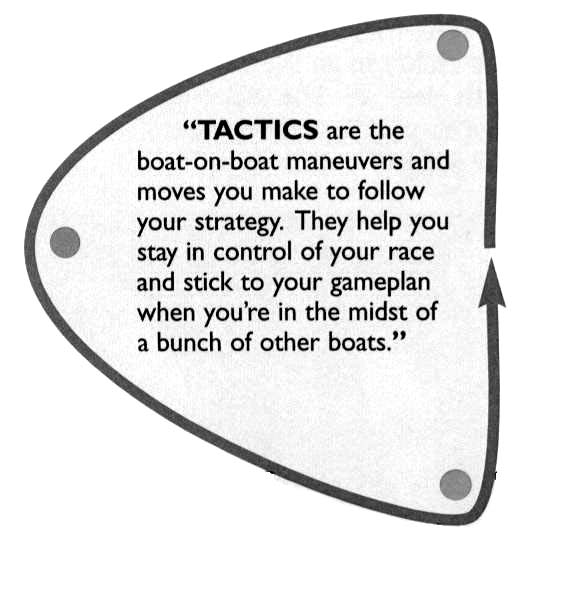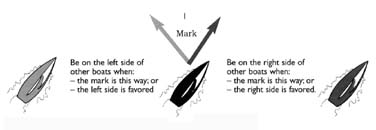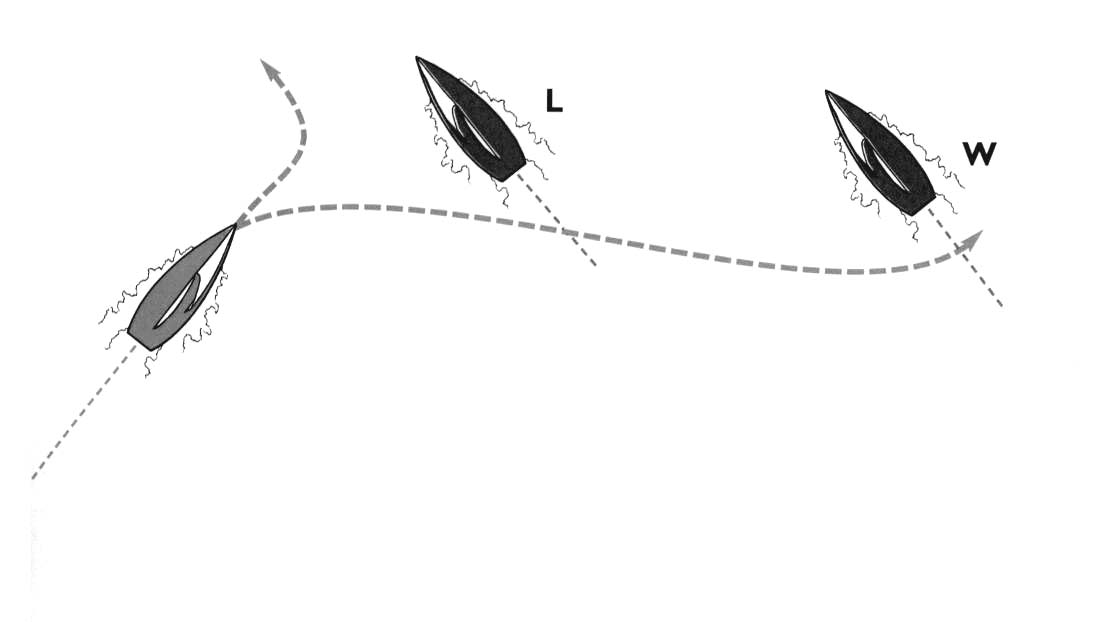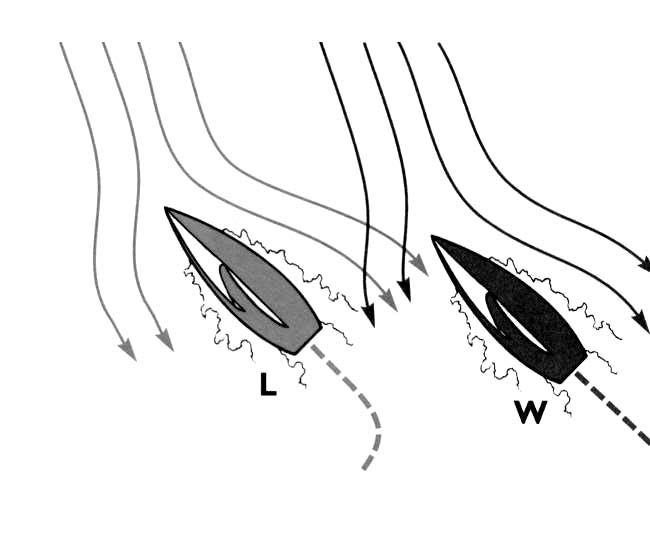
Position Yourself for Success
by David Dellenbaugh
When you’re trying to fight your way to the front of any fleet, there are three tactical goals to keep in mind. First, you must be able to sail your boat as fast as possible. Simply put, you have to avoid the bad air of other boats.
Your second goal is to keep your strategic options open. That is, you must maintain the ability to go left or right, depending on what happens with the wind. If other boats prevent you from tacking, for example, then you have given up options and lost control.
A third tactical goal is to put yourself in the right spot relative to other boats so you are likely to make gains (or avoid losses). This kind of positioning includes covering when you are ahead and staying on the favored side of your nearby competitors.
 |
| Here’s a boat that is positioned to leeward and ahead of its closest competitor. This is one of my favorite positions. It’s especially strong when the boats are on the left side of the course (and port tack is therefore longer), or when the right side of the course is favored. You wouldn’t normally want to be in this position when your strategy favors the left or when you are approaching the starboard-tack layline. |
Tactics is all about how you position your boat with respect to other boats. A strong tactical position is one where you have both clear air and control of your own destiny. You can go where you want with minimal interference from other boats. Here are some of the skills you need in order to be successful tactically:
 |
• Good boathandling - if you want to mix it up with the fleet, you must be smooth and fast.
• Knowledge of the rules - To maneuver in close quarters you need a pretty good understanding of the racing rules; otherwise you will feel intimidated and other boats will be able to take advantage of you.
• Crew communication - Work together so everyone knows the strategy you are pursuing and your potential tactical moves.
• Anticipation - Your goal is to use smart tactics to help you follow your strategic plan. This means you must always have your gameplan in mind, and you have to keep your head out of the boat so you can see what’s coming. The last thing you want is a surprise starboard tacker with no time for deciding what to do.
A. Set up on the favored side of other boats.
If your strategy says play the right side, it may not be enough simply to sail toward that part of the first boat. That’s because if the rest of the fleet goes even farther right, you are actually on the left, at least tactically. Since your goal is to beat the other boats, you must position yourself to their left or right depending on strategic factors.
 |
If the right side of the course is favored, for example, you should stay on the right of your competition. In most cases, it’s better to set up on the side of the other boat(s) that puts you closer to the middle of the course. By staying to leeward and ahead on the long tack to the mark, you’re in better position to play the shifts and make gains.
B. When in doubt, protect the right side of the course.
 |
Usually you pick a side of the course based on strategic factors, but occasionally you go one way because of tactics. When wind and current are equal across the course, consider playing the right side since this will give you the starboard-tack advantage when you converge with other boats. This is most important when you are even with a lot of boats or when you’re getting close to the windward mark.
C. Use a “blocker” to protect your lane on starboard tack.
 |
Sometimes you can actually use the position of other boats to help you follow your strategy. In this situation, W likes the left side of the course and wants to keep going on starboard tack. She has a good lane of clear air right now, but this could change if she is leebowed by a converging port
tacker.
To protect her lane, W uses another starboard tacker (L) as a “blocker.” W must be almost even with L in the race and several boatlengths to windward. Now when a port tacker (P) threatens these boats, P will either lee-bow L or duck behind both L and W. If W is positioned correctly, it won’t be possible for P to duck L and then leebow W. So W’s lane will be safer.
D. Don’t set up too close on either side of another boat.
 |
Unless you are using another boat as a blocker, it’s generally a good rule of thumb to stay away from other boats. Having another boat nearby often limits your strategic options, brings the problem of bad air, and/or presents potential rules difficulties.
For example, the situation shown here is not great for either boat. L has clear air, but she is not close enough to squeeze off W and is therefore pinned from tacking and going left. W may eventually have to pinch to stay out of L’s bad air. In addition, if L hails for room to tack to avoid a starboard tacker, W will have no choice but to tack too and will then be pinned by L. Neither boat controls its own fate.
E. Take advantage of (or beware of) the “leebow positon.”
 |
One strong tactical move is to set up in a so-called “safe leeward position” (Boat L). When you are just to leeward and ahead of another boat (W), you will be sailing in a slight lift as the wind bends around W’s sailplan. At the same time, W will have a header coming off your sails, so you will soon pull ahead.
You normally get into this position by approaching on port tack and then tacking. However, you must be at least bow to bow with the other boat as you converge in order to make this work. Make sure you don’t tack too close to W of you will break rule 13 (Changing Tacks). Also, don’t tack too far away from W or you won’t slow them and they will then pin you from tacking.
Once you tack into a leebow position, work hard at pointing high and squeezing to windward so you force the other boat to tack away quickly. This is essential in order to regain the strategic option to tack whenever you want.
Dave is a two-time America’s Cup veteran who publishes the newsletter Speed & Smarts. For a subscription call: 800-356-2200.